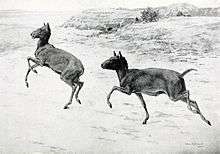Proterotheriidae
| Proterotheriidae Temporal range: Paleocene–Pleistocene | |
|---|---|
| | |
| Thoatherium | |
| Scientific classification | |
| Kingdom: | Animalia |
| Phylum: | Chordata |
| Class: | Mammalia |
| Infraclass: | Eutheria |
| Superorder: | †Meridiungulata |
| Order: | †Litopterna |
| Family: | Proterotheriidae Ameghino, 1887 |
Proterotheriidae is an extinct family of fossil ungulates from the Cenozoic era that displays toe reduction. Despite resembling primitive, small horses, they were not related to them, but belonged to the order Litopterna.
Two subfamilies and 18 genera of Proterotheriidae are known. All forms were small or medium-sized. Typical is a reduction of the number of toes and brachydont or mesodont teeth. The family is recorded since the late Palaeocene. Various fossils are known from many parts of the South American continent. The diversity decreased in the Miocene to Pliocene and it has been assumed for a long time that they entirely disappeared in the late Pliocene. However, fossils found in Argentina and Uruguay show that one member of the group, Neolicaphrium recens survived into the Lujanian.[1] Better known genera of the family include Diadiaphorus or Thoatherium from the Miocene.[1]
Genera
- Proterotheriidae
- Anisolambdinae
- Anisolambda
- Paranisolambda
- Protheosodon
- Richardolydekkeria
- Wainka
- Xesmodon
- Proterotheriinae
- Brachytherium
- Deuterotherium
- Diadiaphorus
- Diplasiotherium
- Eoproterotherium
- Epecuenia
- Licaphrium
- Neolicaphrium
- Prolicaphrium
- Proterotherium
- Prothoatherium
- Thoatherium
- Villarroelia
- Megadolodinae
- Bounodus
- Megadolodus
- Anisolambdinae
References
- 1 2 C.S. Scherer, V.G. Pitana and A.M. Ribeiro: Proterotheriidae and Macraucheniidae (Litopterna, Mammalia) from the pleistocene of Rio Grande do sul State, Brazil. Revista Brasileira de Paleontologia 12 (3) (2009), pp. 231–246 10.4072/rbp.2009.3.06. PDF
| Wikimedia Commons has media related to Proterotheriidae. |
